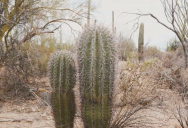Rare Florida Cactus Is Extinct In The Wild Thanks To Climate Change

You hear pretty regularly about the terrifying effects of climate change.
Sometimes it can seem like the consequences are far off – either in time or place – but this cactus is now extinct right here in the United States.
The Key Largo tree cactus is a victim of sea level rise in the Southern US, according to scientists.
The cactus (Pilosocereus millspaughii) was discovered in 1992, and the Florida Keys population has never been huge, around 150 stems.
By 2021, only 6 stems remained.

The same cactus is still growing in the Bahamas and northern Cuba. Researchers say that harsh weather conditions, saltwater intrusion, and mammals grazing contributed to the extinction.
Jennifer Possley, director of regional conservation at Fairchild Tropical Botanic Garden, is the lead author on a study into the population’s decline.
“Unfortunately, the Key Largo tree cactus may be a bellwether for how other low-lying coastal plants will respond to climate change.”

The cactus can grow to over 20 feet tall, with blooms that smell like garlic and reflect the moonlight – both of which help attract bats as pollinators. The fruits are purple and red.
It’s similar to the Key tree cactus, but researchers say there are significant differences, says Alan Franck, a manager at the Florida Museum of Natural History.
“The most striking difference is the tuft of long, woolly hairs at the base of the flowers and fruits. The spines of the Key Largo cactus are also twice as long as those of the Key tree cactus.”
The Key tree cactus has also declined significantly, and has been listed as endangered since 1984. Grazing animals and the increased salt content of surrounding soil is an issue for both of these species.
High ocean tides known as “king tides” are also a big part of the threat.

Researchers collected stem fragments in 2016, but the attempt to save the population failed. They collected the fruits and seeds, the green parts harvested and given to two nurseries.
The only population that remains in the United States is captive – 36 fragments, 25 seedlings, and 1,000 seeds in storage.
All species in the Florida Keys are vulnerable to sea level rise, and scientists in the area are hard at work trying to conserve other at-risk plants.
Thought that was fascinating? Here’s another story you might like: Why You’ll Never See A Great White Shark In An Aquarium

Sign up to get our BEST stories of the week straight to your inbox.




